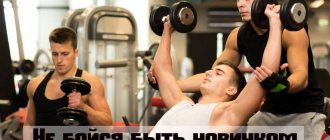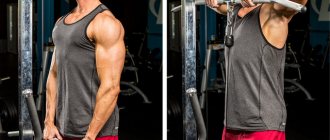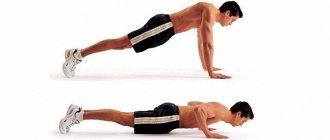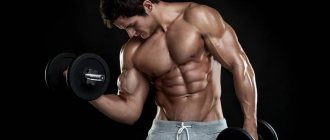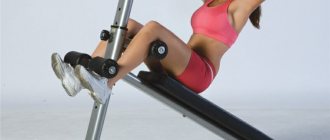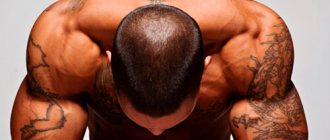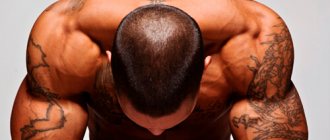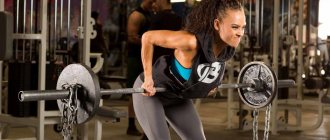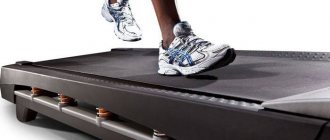Deadlift
Advantages:
This exercise is not just for the back. It affects a range of muscles in the back of the body, from the calves to the upper trapezius. Deadlifts are the best way to work your entire backside. When performing the exercise, it is extremely important to follow the correct technique. Once you master it, increase the weight. This will help you recruit more muscles, release muscle growth hormones, and gain mass.
There are many different deadlift training programs that can help you set your personal bests. Instructors like to suggest the deadlift for building strength and endurance because it works the muscles and is the best for strengthening bone tissue.
Deadlift
Perform classic deadlifts on back day. Other popular variations, such as the sumo deadlift, target other muscles.
When to do it:
If you're doing heavy deadlifts (maximum 6 reps), it's best to do them early in your workout, when you're still full of strength. If you intend to perform many repetitions, but with light weight, then you can do this exercise at any time.
A little anatomy
Before you begin directly performing the corresponding exercises, you must have at least a superficial understanding of the anatomy of the human body. This will allow you to choose the right training program that will be most effective. It is customary to distinguish between a complex of superficial and deep muscles, each of which performs its own strictly defined function.
The superficial muscles usually include the latissimus muscles, which athletes and bodybuilders often call “wings.” They are located in the lower back, responsible for the movement of the arms. Also classified as superficial is the quadratus muscle, which allows you to tilt and bend the torso. If you need to achieve noticeable relief, this group should be given maximum attention when performing basic strength exercises.
Deep muscles - semispinalis and multifidus. Their main purpose is movement and support of the spine. It is also customary to highlight the deep extensor muscles, including the iliocostalis and longissimus, which allow the human body to bend back and forth. In the upper back are the rhombus and deltoid muscles, which support the shoulder blades and provide movement to the shoulder girdle.
When working out in the gym, you need to work out the following back muscle groups:
- oblique;
- lats;
- trapezoidal;
- diamond-shaped;
- straightening the spine.
Basic exercises for back training will be almost the same for women and men. The differences are only in the maximum possible load. It has been established that the female body is more resilient than the male body, however, the fair sex does not cope well with heavy weights.
Therefore, to properly work out the back, girls need to exercise with light dumbbells or perform deadlifts with minimal load, but at the same time performing more repetitions and approaches.
Bent-over barbell row
Advantages:
This exercise ranks second among heavy lifting exercises. Research has shown that the bent-over row works both the upper and lower muscles equally, making it an excellent exercise for working the entire back. Like the deadlift, this exercise requires perfect technique, but it's worth it.
Bent-over barbell row with straight grip
When to do it:
Practice bent-over rows with heavy weights at the beginning of your workout, the number of repetitions per set is from 6 to 10 times. Doing this exercise in a Smith machine is also a good option. The machine keeps you in a vertical plane, but you need to make sure that your body is in the correct position relative to the bar. The bent over row puts much more stress on the lower back than other exercises. It’s worth taking pity on your lower back and doing this exercise at the beginning of your workout. If you're exhausted after deadlifting, it might be best to skip the bent-over row altogether.
Back training program
Rest 30-60 seconds between warm-up sets
Rest 60-90 seconds for working sets
Reverse grip pull-ups6 sets of 10 reps (body weight) |
Bent-over barbell row2 warm-up sets of 6-10 repetitions; 3 working sets of 6-10 reps |
Vertical pull-down to the chest2 warm-up sets of 8-12 repetitions; 3 working sets of 8-12 reps |
Horizontal block row to the stomach3 sets to failure; approximately 6-8 reps |
Wide grip pull-ups
Advantages:
Pull-ups are an excellent exercise for the back muscles. In wide-grip pull-ups, the main focus is on the upper latissimus muscles. A narrow grip increases the range of motion, but a wide grip places the body in a better starting position. The most difficult thing in this exercise is to maintain the desired pace with the number of repetitions from 8 to 12 times.
If you're doing pull-ups at the beginning of your workout, use a weight belt. If you find it difficult to perform this exercise, you can always replace it with a pull-up machine or use the help of a spotter. Also, a full-fledged replacement would be pulling the block down with a wide grip. If everything is in order with the shoulder joints, you can pull the block down behind your head.
It is extremely important to follow the execution technique: in the starting position, the shoulder blades should be brought together.
Wide grip pull-up on the horizontal bar
When to do it:
This exercise has a large range of motion, so a few repetitions will be enough to warm up the shoulder joints. Perform pull-ups at the beginning of your workout to focus on technique.
How to pump up your upper back in the gym
To effectively pump the upper back muscles and give them attractive definition, you should pay special attention to training in the gym. This complex consists of the best exercises for the upper back, by performing which you can not only build muscle mass, but also strengthen the spine and lower back. We recommend a set of exercises in the gym for beginners.
A set of exercises for the upper back in the gym
| Exercises | Sets | Repetitions/Time |
| Wide grip pull-ups | 3 | 8-12 |
| Vertical block row in front of you | 3 | 15 |
| Pullover dumbbell | 3 | 10-12 |
| Reverse fly with dumbbells | 3 | 15-20 |
| Shrugs with a barbell | 3 | 20 |
Wide grip pull-ups
Performance:
- Grab the horizontal bar with an overhand grip. The distance between the hands corresponds to the width of the shoulders. Relax your torso. Cross your legs together.
- Bend at the waist. Pull yourself up. Touch the bar with your chest. Try to bring your shoulder blades together. Do the exercise slowly. Don't swing.
Vertical block thrust
Read: A set of back exercises with dumbbells for men
Performance:
- Take a seat in the exercise machine. Grab the bar so that the distance between your hands is greater than shoulder width.
- Exhaling, lower the bar to your chest. Stay in position for 2 seconds.
- Take a breath. Smoothly return the block to its previous position. Your arms should be fully straightened.
Vertical block thrust
Pullover dumbbell
Performance:
- Lie across or along the bench. The upper back and neck will be on it. The side surface of the bench will become a support for the head.
- Raise your arms with a dumbbell above your head. Then lower it behind your head, maintaining the position at the lowest point. Return to the starting position.
Reverse fly with dumbbells
Read: Quadratus lumborum exercises
Performance:
- Sit on a bench. Press your chest towards your legs. Hold dumbbells in slightly bent arms.
- Raise your arms with dumbbells. Stay at the top. Repeat the movement you have already mastered.
Reverse fly with dumbbells
Shrugs with a barbell
Performance:
- Grab a barbell and hold it while standing. Place your arms along your body.
- At the same time, raise your shoulders as high as possible. It is permissible to lower your chin: this will increase the load on the muscles.
- Drop your shoulders. The arms remain straight. Do not relax your shoulders at the lowest point, do not rotate them for the safety of your joints.
Shrugs with a barbell
How to pump up the upper back for men: training nuances
For men, it is enough to exercise twice a week to pump up the back muscles. Do the exercises as many times as your physical fitness allows. Use weights whenever possible. Try to progress the load. You should start your workout with basic back exercises and end with isolated exercises. After each strength exercise, stretch your muscles. Men who are aiming to work on muscle mass and back relief should perform the exercises 15 times in 3 approaches. If the goal is to develop strength, reduce the repetitions to 7. When working on endurance and strengthening the back, do 20-25 repetitions.
Read: Complex: healthy spine and lower back
Features of women's training
Start training by performing a small number of repetitions. Additional weight should not exceed 5 kg. Women should pay attention to basic exercises for the upper back. It is preferable to perform rows of blocks, dumbbells, and pull-ups in a gravitron. Don't get carried away with deadlifting. If you feel discomfort, take a break and stretch the muscles being trained. Women are recommended to perform exercises of 15 repetitions in 3 sets.
Video: Back training in the gym ⇓
Standing T-bar row
Advantages:
For pumping up the back, the standing T-bar row is better than the lying barbell row on a bench, despite the fact that standing increases the load on the knees and hips. If you find it difficult to keep your back straight, do this exercise while lying down.
There is no need to squat too much; keep your knees slightly bent at all times. The position of the hands and the width of the grip can be varied. A wide grip works the latissimus muscles, while a neutral grip will allow you to concentrate on pumping the muscles of the middle part of the back: rhomboids, round and trapezius muscles. This exercise is one of the easiest on our list.
Standing T-bar row
When to do it:
It is recommended to perform in the first part of the workout. Focus on stretching and contracting your back muscles rather than lifting heavy weights. Increase the range of motion by slightly spreading your shoulder blades at the bottom. Make sure your back is straight at the beginning of each movement.
Wide grip lat pulldown
Advantages:
Compared to block rows with a narrow grip, a wide grip allows you to better work the upper latissimus muscles and adds variety to your workout. If you are performing wide-grip lat pull-downs, you should not use back machines on the same day, because they give the same load on the same muscles. If you change the grip width and move your hands to shoulder width, trying to press your elbows to your body as you move, the lower latissimus muscles will be more loaded.
Wide-grip horizontal block row to the waist
When to do it:
Like machine exercises, pull-downs are best done toward the end of your workout. Choose a weight so that you can do no more than 12 repetitions.
A selection of exercises for back thickness
Some of the exercises for back thickness can be performed in the gym, and some are quite suitable for home training. Everyone has one goal, which means one common feature - a narrow grip, both for horizontal and vertical rows, which develop the thickness of the back.
Reverse Grip Lat Pulldown
This exercise is performed in a special block simulator for vertical traction. To perform the technique, you will need a straight, wide handle.
- Place your palms on the handles with a reverse grip from below, shoulder-width apart.
- Sit on the seat and place your thighs under the support bolsters.
- In the starting position, the arms should be straightened above the body, and the body should be slightly tilted back.
- As you exhale, using the strength of your lats, but not your biceps, pull the handle toward your upper chest—closer to your collarbones. The elbows should literally slide along the body. At this moment, it is important to bring your shoulder blades together and bend slightly in the thoracic region, contracting your lats as much as possible. The body does not change position.
- As you inhale, slowly straighten your elbows, returning to the starting position. Perform the negative phase without jerking, stretching the back muscles at the top.
Horizontal block pull to the belt
For horizontal rows you will also need a special block simulator. You will also need a handle for a parallel grip, which will ensure the development of muscle thickness.
- Attach the handle to the block and select the required working weight.
- Sit on the seat and rest your feet on a special platform or supports. Grab the handle with a parallel grip. Sit back so that when you pull the cable with your outstretched arms, the weight plates are in the air.
- Your knees should be slightly bent and your back straight, maintaining a natural arch in your lower back.
- As you exhale, stretch the handle toward your waist, bringing your elbows as close to your body as possible. Squeeze your shoulder blades and arch your chest, allowing your lats to contract to their maximum.
- As you inhale, slowly straighten your elbows, stretching your arms in front of you to the starting position, but do not tilt your torso forward behind the weight. The slabs must always be covered.
Reverse grip pull-ups
A universal exercise that can be performed in the gym, on the street, and even in your own apartment if you have a horizontal bar. The peculiarity of these pull-ups is the use of a reverse grip.
- Place your palms on the bar with an underhand (reverse) grip, shoulder-width apart.
- While hanging, always keep your elbows fully extended to take extra stress off your biceps.
- Exhale and pull your chest toward the bar, keeping your elbows as close to your body as possible. Squeeze your shoulder blades and bend your chest.
- It is important to pull yourself up using your back muscles, not your arms.
- As you inhale, slowly straighten your elbows.
Linkage
The deadlift is performed on a lever machine using parallel handles.
- Place the same weight of weight discs on both sides of the machine.
- Sit on the seat and rest your chest against a special pillow, place your feet on the platform.
- Grab the parallel handles, straighten your back, and exhale as you do chest rows, trying to keep your elbows close to your body. At the peak of the contraction, squeeze your shoulder blades and arch your chest, holding a short pause.
- As you inhale, slowly straighten your arms to the starting position.
Bent-over T-bar row
The exercise is performed on a special device for T-shaped traction. If you perform rows to the chest, then the upper part of the latissimus muscles will work to a greater extent, and if to the waist, then the lower part.
- Set the working weight and stand on the platform or floor above the bar.
- Grab the handles for the T-pull and build the starting position: the angle of the torso is slightly higher than parallel to the floor, the arms are freely lowered. Keep your lower back in a natural arch. Bend your knees slightly.
- Exhale and pull the bar toward your chest, squeezing your shoulder blades together. Do not round your back or change your angle.
- As you inhale, slowly lower the bar.
Bent-over barbell row
This exercise can be performed at home, the main thing is to have a straight bar and the required weight for it.
- Place the barbell on the floor or on dedicated deadlift racks.
- Grasp the bar with your palms using an overhand grip, shoulder-width apart.
- Raise the apparatus and stand in the starting position: tilt your torso forward, the closer the tilt is to the horizontal, the more the upper back will work, and vice versa. Bend your knees slightly. Lower your arms with the barbell down freely.
- As you exhale, pull the barbell toward your waist, bringing your shoulder blades as close as possible to each other. Bend your chest at the top.
- As you inhale, gently lower the barbell to the starting position.
Read more about bent over rows →
Bent-over dumbbell row
To perform deadlifts, you will need two dumbbells of the same weight.
- Take dumbbells and bend your torso forward, just above the horizontal line, and lower your arms freely down.
- As you exhale, stretch the dumbbells with a parallel grip to your waist, keeping your elbows closer to your body. Squeeze your shoulder blades and arch your chest at the peak of muscle contraction. Do the effort exclusively with the latissimus muscles.
- As you inhale, straighten your arms.
Row of one dumbbell to the belt in support
To perform deadlifts, you will need a bench or chairs for support.
- Place one palm and the same knee on a hill, tilting your torso parallel to the floor. Hold the dumbbell loosely in your other hand, and rest your other foot on the floor for balance.
- As you exhale, pull the dumbbell toward your waist, contracting the latissimus muscle, pausing at the top point.
- As you inhale, slowly lower the dumbbell.
- Then repeat on the other side.
Read more about one-arm dumbbell rows →
Smith Machine Reverse Grip Row
Advantages:
The reverse grip engages the biceps and keeps the elbows close to the body, placing the load on the lower lats. Smith machine training allows you to concentrate on increasing your weight without worrying about maintaining your balance.
When performing the exercise, stand close to the barbell and tilt your body at an angle of about 45 degrees. When using heavy weights, you may feel stress on your knees and hips. Some experienced bodybuilders consider the Smith machine to be dangerous to the joints, but the stability of the body during movement and the ability to work with heavy weights make it suitable for beginner athletes.
When to do it:
It is enough to perform one exercise using a reverse grip per workout. Do Smith machine rows in the middle of your workout after doing overhand pull-ups. Use traction straps to take your mind off the grip and focus on working your back muscles.
Close-grip lat pull-down
Advantages:
Wide-grip lat pull-downs are similar to wide-grip pull-ups, so we'll use a narrow-grip version for this exercise. Research has shown that using a narrow neutral grip is the same as a regular grip: the same muscles will be used. A narrow grip gives a greater range of motion and increases the exposure time for the latissimus muscles.
Close-grip lat pulldown to chest
When to do it:
If you want to not just stretch your shoulders, but build muscle mass, then it is better to perform this exercise at the end of your workout, doing sets of 8-12 repetitions.
Make movements at a slow pace, contracting the muscles at the bottom and stretching them as you move up.
Vertical block thrust
The vertical pull-down is an exercise whose mechanics are very similar to pull-ups. If you find it difficult to do pull-ups with your own weight, then it is better to replace them with vertical pull-downs. If you want to thoroughly refine (finish off) your lats, then you can also turn to this exercise. The vertical block row allows you to slightly isolate the auxiliary muscles, thereby concentrating the load on the target ones.
- To perform the exercise, we will need a special simulator for block rows. Install the required handle on the upper mount of the machine. Adjust the foot rest to a comfortable height so that it presses your feet firmly against the floor. After installing the necessary weights on the simulator, you can begin to perform.
- The mechanics of performing the exercise consist of lowering/raising the handle in a vertical plane. The exercise is performed in a similar way to pull-ups. The handle is pulled towards the chest. At the top point, the handle is at the top, the arms are extended. At the bottom there is a handle below at chest level, the body is tilted slightly back. Lowering/raising the handle is carried out in front of the head.
The exercise consists of 1 warm-up approach and 3 working sets. The warm-up approach is done with 60-70% of the working weight. Number of repetitions in warm-up and working approaches: 8-10.
For a visual representation of how to perform the exercise correctly, watch the video below:
It's a lat pulldown, baby!
One-arm dumbbell row
Advantages:
This is a great unilateral exercise where each side works independently of the other, allowing for heavier weights to be used. Such exercises increase the range of motion and relieve stress on the lower back - you can lean on the bench with your free hand. A slight rotation of the body also engages the core muscles.
Bent-over dumbbell row with one hand
When to do it:
Provided that you keep your elbow pressed to your body, the main load will fall on your lower lats. Perform the exercise in the second part of the workout for 10-12 repetitions.
Pullover with dumbbell lying on an incline bench
Advantages:
Not everyone knows this, but pullovers are mostly a back exercise. The incline pullover uses the same muscles as the straight-arm lat pullover. This is a single-joint exercise that allows you to concentrate exclusively on working the latissimus muscles. Performing this exercise on an incline rather than a flat bench increases muscle load due to a greater range of motion. Lower the dumbbell behind your head, touching the floor at the bottom of the movement.
Incline Dumbbell Pullover
When to do it:
Single-joint exercises are almost always performed at the end of a workout on a specific body part. Don't slow down and do 12-15 repetitions per set.
How to properly pump up your back muscles
1Focus on multi-joint exercises
Calum's best advice is to start with multi-joint exercises.
This is the best route for beginners. That's how he started out. Calum believes that core exercises will not only help develop your back, but will also help with coordination and strengthen your core. Choose movements like deadlifts—which work your back, legs, and glutes—as opposed to isolation exercises like straight-arm cable rows. Another rule is never sacrifice technique for more weight. Throwing a bunch of iron onto a barbell to increase the size of your back on a barbell deadlift is a recipe for diminishing results, not adding mass.
Calum has been taught by many years of experience to monitor the technique of performing exercises. He says he's tried and used heavy weights before, both for deadlifts and bent-over rows, but it's not good for muscle building.
2Create a brain-muscle connection (neuromuscular connection)
To tone up his massive back, Calum focused on neuromuscular connections and the muscles began to grow.
Although he has always had a well-defined and prominent back, Calum hasn't always enjoyed training this specific body part. He would rather bench press or squat to strengthen his quads. But last year he noticed a difference in the width and thickness of his back, which prompted him to take action.
Calum has also recently created a strong mental connection with his back. He says the best thing about back training now is the brain-muscle connection that I have. He usually tries his best to activate his back muscles. Calum says he didn't know how to stretch before, but now he can do multiple stretches, which makes the workout much more effective.
3Pull, Pull, Pull
When it comes to your back, barbell rows and wide-grip pull-ups should come to mind. Calum believes that for a good, wide back, the bent over row is ideal because it initially targets the middle of the trapezius muscle, which lowers the center of your back.
Combine it with a lat pulldown to develop width. Think about your back during every workout to maximize the involvement of all fibers.
4Stretch and contraction
To build a powerful back, the key is that you stretch and contract every muscle at the peak of each set. Isometric exercises—such as stretching, counting to 5, and relaxation—help activate and fatigue this muscle.
Any isometric exercise increases the time the muscle is under load and strengthens the neuromuscular connection with each movement. The result is more than just a great mass!
The correct technique for performing the exercise and involving the maximum number of muscle groups and muscle fibers in the work will help pump up a massive back.
Are you ready to put these tips into action? Start working on your back using Calum's advice. Push yourself to lift heavy weights the way you need to, but stick to proper form and rest periods.
